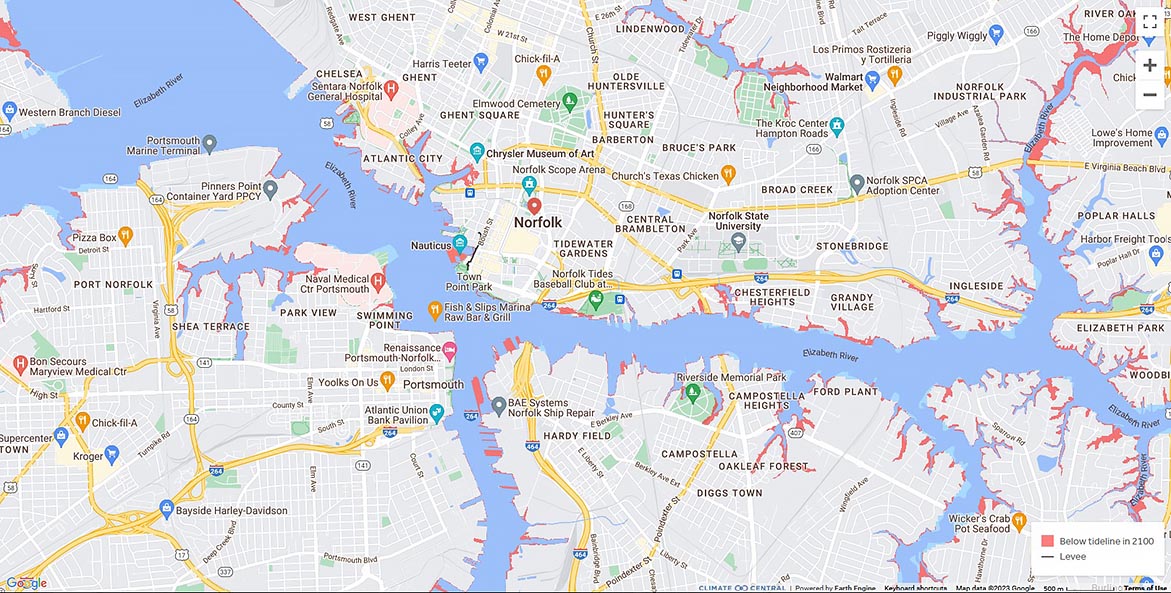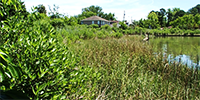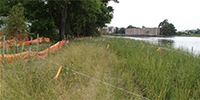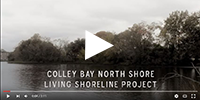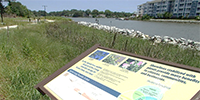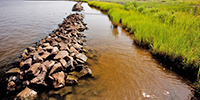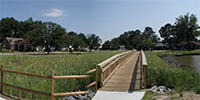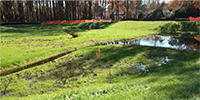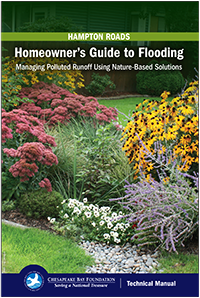Cities and towns near the Chesapeake Bay are facing a major threat from sea-level rise. The good news is that nature-based solutions can help us adapt to recurrent flooding. In fact, coastal Virginia has seen the highest rate of relative sea-level rise on the whole Atlantic coast, more than 14 inches since 1930. The Hampton Roads region is particularly at risk because, in addition to rising seas, the land is also sinking. In coastal Virginia recurrent floods already inundate city streets and homes, while frequent storms batter infrastructure.
The good news is that there are ways to adapt to recurrent flooding, as well as address rising waters, using nature-based solutions. Learn about successful Virginia projects that use these practices.
Large scale shoreline protection techniques like living shorelines, living breakwaters, and oyster reefs, all stabilize the waterfront against the force of waves and storms.
Smaller scale techniques, like rain gardens, tree boxes, vegetated swales, permeable pavers, rain barrels, and downspout disconnections, hold and filter rainwater into the ground rather than letting it wash off hard streets and buildings and into creeks and rivers. This relieves pressure on overwhelmed city systems that struggle to address this regular deluge of polluted runoff.
Natural Approaches Improve Water Quality
These approaches based on natural systems have so many benefits. In addition helping us adapt to sea-level rise, many of these techniques also lead to cleaner water in rivers, creeks, and the Chesapeake Bay.
Living shorelines and living breakwaters reduce the impact of storm waves and provide critical habitat, in turn creating homes for wildlife and improving fisheries. Small scale infiltration projects absorb flood waters, remove water pollution, and increase the ability to hold polluted runoff from rainfall. Ultimately, these projects also create beautiful green spaces for people to enjoy, making communities more livable and economically attractive.
CBF Highlights Opportunities for Nature-Based Solutions
CBF is highlighting natural solutions for adapting to sea-level rise in Virginia that can both protect cities and suburbs and improve local water quality. Under a grant from the Blue Moon Fund, CBF Sea Level Rise Fellow Thomas Quattlebaum is working with officials and local governments in Hampton Roads on cost-efficient ways to address rising waters. "For example, if you're tearing up a city road to update infrastructure, there may be an opportunity to incorporate nature-based infiltration options like rain gardens that can help with our current flooding problems as well as better prepare us for impending sea-level rise threats and improve water quality for now and well into the future," according to Thomas.
CBF is studying and promoting proven nature-based techniques that will help communities prepare for the challenges ahead.
Find out more below or on our interactive map.
Success Stories
These case studies outline successful nature-based solutions to recurrent flooding and sea-level rise in Hampton Roads, Virginia.
Birdsong WetlandsNorfolk's first living shoreline withstands storms and hurricanes (Birdsong Wetlands, Norfolk, Va.) |
Chesterfield HeightsPreserving history by preparing for sea-level rise (Chesterfield Heights, Norfolk, Va.) |
Colley BayReplacing concrete and debris with native wetlands (Colley Bay, Norfolk, Va.) |
|
Replacing concrete and debris with native wetlands (Colley Bay, Norfolk, Va.) |
Haven CreekLiving shoreline revitalizes a waterfront promenade (Haven Creek, Norfolk, Va.) |
Money PointTidal marsh restoration and oyster reef proves habitat-based resiliency (Money Point, Chesapeake, Va.) |
Myrtle ParkWetlands restoration converts a barren eyesore into a beautiful park (Myrtle Park, Norfolk, Va.) |
Paul Burbank Elementary SchoolRain gardens and wetlands lead to less flooding and cleaner water in Hampton neighborhood (Paul Burbank Elementary, Hampton, Va.) |
American RiversAmerican Rivers has more case studies on successful projects around the country. |
American Society of Landscape ArchitectsASLA also features case studies from across the U.S. |
Chesapeake Bay FoundationCBF has also compiled a directory of successful nature-based solutions to flooding and sea-level rise in Hampton Roads and Richmond here. |
Homeowner's Guide to FloodingOnce in place, these steps can help alleviate flooding problems and keep pollutants out of local waterways. They are just some of the many practices that you can use to accomplish this and also beautify your neighborhood, save money, attract wildlife, and provide other benefits. |

